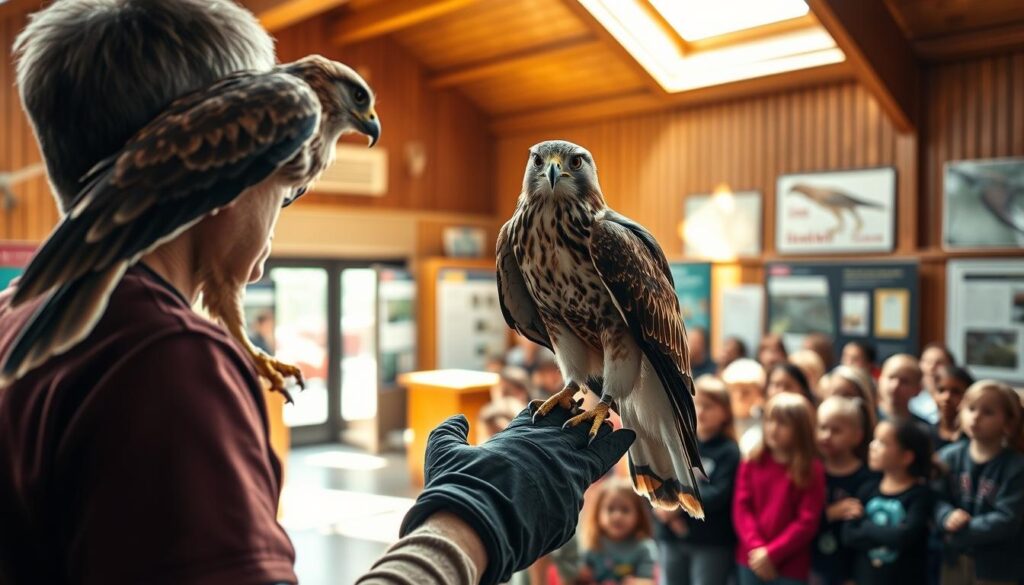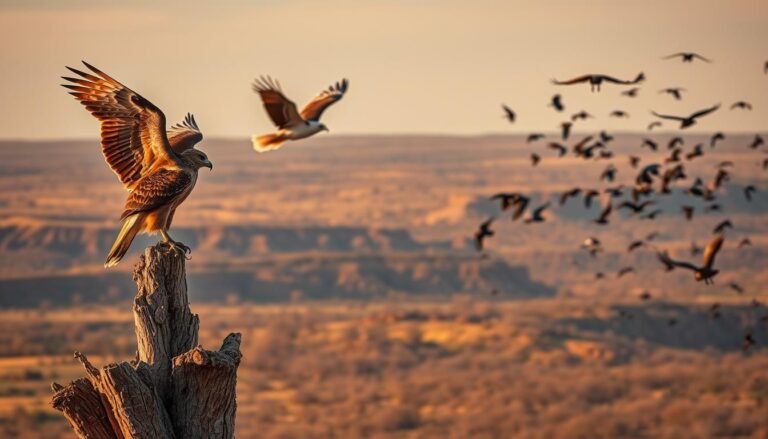Birds of Prey Alabama: Welcome to a fascinating journey through Alabama’s birds of prey, or raptors. We’ll explore eagles flying high and stealthy owls in the woods. These species, their homes, actions, and how we protect them make for an exciting story. Alabama’s special places are perfect for these amazing birds. This guide will help you learn about these predators, their cool features, and why they matter to nature.
Birds of Prey Alabama Key Takeaways
- Alabama is home to a variety of birds of prey, including eagles, hawks, and owls.
- Raptors play a crucial role in maintaining ecological balance.
- Many species migrate and can be spotted in specific seasons.
- Conservation efforts are essential for protecting these magnificent creatures.
- Birdwatching opportunities abound in Alabama’s diverse habitats.
Introduction to Birds of Prey in Alabama
In Alabama, birds of prey play a big role in nature. These birds, often called raptors, are important for the ecosystem. They help keep things balanced. Let’s learn about their features and why they matter.
What Are Birds of Prey?
Raptors include eagles, hawks, and falcons. They have sharp eyes to spot prey far away, strong claws to catch and kill, and hooked beaks to tear apart their food. In Alabama, these birds add to the variety of wildlife. They show how well they can live in different places.
Importance in the Ecosystem
Birds of prey are crucial in the ecosystem. As top predators, they control the number of smaller animals. This stops too many from living in one place and keeps things balanced. They show us that Alabama’s environment is healthy. This makes them key for keeping nature diverse and helps in saving their living spaces.
Common Types of Birds of Prey Found in Alabama
Alabama is home to a wide variety of birds of prey. Each type has its own unique features and roles in nature. Eagles, hawks, and falcons are some of the majestic predators you’ll find.
Eagles: Majestic Apex Predators
The Bald Eagle is prominent in Alabama, known for its white head and tail. It has a dark brown body. Adults may weigh up to 14 pounds and reach 42 inches in height. These eagles are strong and form lifelong bonds with their mates. They work together to raise their young.
Hawks: Versatile Hunters
Alabama hosts seven hawk species, including buteos and accipiters. The Red-tailed hawk is easily recognized, with a size of 17.7 to 25.6 inches and a weight of 24.3 to 51.5 ounces. You might see them perched by roads or flying overhead.
The Red-shouldered hawk is another, sizing 16.9 to 24.0 inches and weighing 17.1 to 27.3 ounces. Hawks in Alabama are known for their impressive speed, sharp eyesight, and quick movements in hunting.
Falcons: Speed and Agility
Falcons in Alabama are admired for their speed and agility. The Peregrine Falcon is among the fastest, diving over 200 mph to catch prey. The American Kestrel, small at 9 to 12 inches, performs incredible aerial tricks. These predators focus on hunting smaller birds and insects efficiently.
Habitats of Birds of Prey in Alabama
Alabama is home to a wide range of ecosystems. Each one offers a unique home to many birds of prey. By learning about these places, we can better understand the variety of raptors in Alabama. Every area helps support different birds, adding to the state’s wildlife wonder.
Forests and Woodlands
Alabama’s forests and woodlands are crucial for birds of prey. Here, the Red-shouldered Hawk and Cooper’s Hawk make their homes. They rely on the thick tree cover for nesting and finding food. These environments are rich in small animals and birds, which are essential for their survival.
Open Fields and Grasslands
The Broad-winged Hawk and Swallow-tailed Kite thrive in open fields and grasslands. These birds fly high above the ground, looking for their next meal. The vast, open landscapes help them spot and catch their prey, making these areas vital for their hunting success.
Wetlands and Riverbanks
Ospreys, with their unique fishing technique, depend on wetlands and riverbanks. These places have plenty of fish, making them perfect for feeding. Alabama’s numerous waterways make it an ideal place for many types of raptors. They find not just food but also play a key part in the local ecosystem.
Birdwatching Opportunities in Alabama
Alabama is a top spot for watching birds, especially birds of prey. It has over 430 bird species. The state’s parks and reserves are perfect for seeing many bird types.
Best Locations for Spotting Birds of Prey
Some of the best locations for birds of prey include:
- Wheeler National Wildlife Refuge: It’s famous for its winter guests: geese, ducks, and Sandhill Cranes. It’s also great for seeing Bald Eagles.
- Cahaba National Wildlife Refuge: This 4,000-acre area draws Ospreys and Red-tailed Hawks.
- Eufaula National Wildlife Refuge: Spread over two sections in Alabama, it’s ideal for birdwatchers looking for raptors.
- Gulf State Park: Known for its beauty, you can also see nesting Bald Eagles and various shorebirds here.
- Lakepoint State Park: A hotspot for birdwatching, it hosts Ospreys, Bald Eagles, and Brown-headed Nuthatches.
Tips for Birdwatching Success
For a great bird watching experience in Alabama, follow these tips:
- Use Quality Binoculars: Good binoculars make it easier to see birds from far away.
- Choose Optimal Times: Try early morning or late afternoon for the best bird sightings.
- Stay Quiet: Being quiet means you won’t scare the birds away, so you’ll see more.
- Be Patient: If you wait quietly, you might be surprised by what shows up.
- Join Local Groups: Local birdwatching groups can offer helpful advice and tips.
Conservation Efforts for Birds of Prey
In Alabama, groups are working hard to protect birds of prey. They focus on ensuring these beautiful species survive. Organizations dedicated to bird conservation are key in maintaining habitats, educating the public, and pushing for supportive laws.
Organizations Dedicated to Their Protection
The Alabama Audubon Society is a leading group in this effort. They create programs to help birds of prey. They work on restoring habitats and teaching the community about these birds. Their efforts have helped bring back species once near extinction.
Legislative Measures Affecting Their Habitat
Laws play a big part in protecting birds of prey. Protecting their habitats helps keep their ecosystems stable. As more people realize how urban growth and farming harm these areas, more action is taken in Alabama.
Working with local governments and others, groups ensure laws to protect these environments are followed. This keeps the birds’ homes safe for years to come.
Distinguishing Characteristics of Alabama’s Birds of Prey
The birds of prey in Alabama have unique traits that stand out. We can better understand their importance in nature by looking at their hunting methods and what they eat. These birds differ in size, look, and how they catch food, making them key to Alabama’s wildlife.
Size and Appearance
These predators vary greatly in size. Take the Barred Owl, which can be 20 to 24 inches long with a wingspan of 40 to 50 inches. Their colors and patterns aren’t just for show. They help them hide in their habitat. The Swallow-tailed Kite, known for its long body, has a wingspan over four feet, showing off its size among the raptors.
Hunting Techniques and Diet
The way these raptors hunt is quite different from one another. The Barred Owl hunts mostly at night, using its amazing night vision to spot prey. On the other hand, the Cooper’s Hawk sneaks up on its prey, changing its approach with the environment. These birds eat various things; Barred Owls mostly eat small mammals but also go for birds, reptiles, and insects. Their wide-ranging diet shows how adaptable they are and their big role in the ecosystem.
Seasonal Migration Patterns
In Alabama, many birds of prey follow distinct migration patterns throughout the year. These patterns are influenced by environmental factors. Understanding this reveals the amazing journeys these birds go on annually. Species like the Peregrine Falcon and the American Kestrel migrate to warmer places or where food is more plentiful at certain times.
When Do They Migrate?
In Alabama, birds that migrate do so on a schedule we can often predict:
- Peregrine Falcon: Usually departs by late spring, migrating thousands of miles to its summer breeding grounds.
- American Kestrel: Often leaves Alabama by early spring, seeking territories that offer better feeding opportunities.
- Merlin: Tends to migrate away from Alabama in early April, highlighting the importance of timing in its life cycle.
Factors Influencing Migration
For birds of prey in Alabama, several things influence their migration:
- Food Availability: They may move to where food is more available as prey numbers change with the seasons.
- Weather Patterns: Weather changes tell them it’s time to migrate for better conditions.
- Breeding Needs: The need to find places to breed can also guide when and where they migrate.
Threats Facing Birds of Prey
Birds of prey in Alabama face many challenges. These challenges threaten their survival. It’s vital to know these key threats for conservation.
Habitat loss and pollution are the biggest problems. They greatly affect bird populations.
Habitat Loss and Urbanization
Habitat loss due to urban growth is a major threat. As cities grow, natural spaces and wildlife areas get replaced. This means fewer homes and food sources for birds.
For example, the red-tailed hawk needs open spaces to live. But development is taking over these areas. This leads to fewer birds and less chance for them to have babies.
Pesticides and Environmental Pollution
Pesticides are a big risk to these birds. These chemicals can build up in the food chain. This harms the birds’ prey and, in turn, the birds themselves.
Studies show that pesticides can make raptors sick. This includes problems having babies and more death. Pollution also harms their food and health. We must support clean farming to help save these birds.
| Threats | Description | Impact on Birds of Prey |
|---|---|---|
| Habitat Loss | Urban expansion and agriculture reducing natural habitats | Decreases nesting and hunting opportunities |
| Pesticides | Chemicals that accumulate in food sources | Health issues and reproductive failures in raptors |
| Environmental Pollution | Contaminants affecting ecosystems | Alters prey populations and bird health |
Educational Programs on Birds of Prey

In Alabama, many projects teach about birds of prey. They aim to raise awareness and love for these beautiful raptors. Workshops are offered for all ages. They help people learn more about these important birds.
Local Workshops and Seminars
Local workshops give hands-on learning and insights. You need to book them a month ahead for good planning and engagement. After you ask for a spot, they’ll reply in 5-7 days with program details.
These sessions last 1 to 2 hours. They have interactive parts like:
- Up-close meetings with trained raptors
- Talks on raptor biology and conservation
- Chances to go birdwatching in places like Weeks Bay National Estuarine Research Reserve
Resources for Schools and Communities
Schools and communities get a lot from these programs. They offer tools for teachers to help students learn about birds of prey and their roles. The programs are held in beautiful places in Alabama.
Program prices start at $200.00, going up to $500.00 for extra options like event booths. Paying by credit card adds a 3% fee. Going to places like Oaks Mountain State Park costs a little extra. But, active military and veterans can get in for free. This shows a strong commitment to everyone being able to join in.
The main goal of these programs is to make people feel closer to nature. This helps everyone work together more on taking care of our environment. If you cancel less than 48 hours before, you can’t get your money back. This rule highlights how important it is for participants to be really committed.
| Program Type | Duration | Cost | Participants Required |
|---|---|---|---|
| Standard Workshop | 1 hour | $200.00 | 1 chaperone per 5-10 students |
| Extended Workshop | 2 hours | $300.00 | 1 chaperone per 5-10 students |
| Special Event Booth | Variable | $500.00 | Based on event size |
Role of Birds of Prey in Native American Culture
Birds of prey are important in Native American traditions. They symbolize strength, freedom, and wisdom. Many tribes see these birds as links between our world and the spirit world.
Symbolism and Spiritual Significance
In some tribes, the Great Horned Owl and Screech Owl symbolize life and death. The Cherokee, Lakota, and Cheyenne see owls as important messengers. They believe owls deliver messages to medicine men about future events.
For some, an owl in daylight is a bad sign, while others see it as a protector. Dreaming of an owl can give someone a protective spirit. This shows how deeply connected owls are to people’s well-being.
Folklore Involving Birds of Prey
Native American stories are full of birds of prey. These stories tell about their connection with humans. In these tales, the Short-eared Owl is seen as a true owl, while others are considered spirits.
Warriors used owl feathers on shields for night vision and silence. Cherokee shamans would ask the Eastern Screech Owl for help with sickness. These stories show how these birds are part of both the natural and spiritual world of Native Americans.
Future of Birds of Prey in Alabama
The future of birds of prey in Alabama depends on current research and committed conservation efforts. Studies in Alabama are looking into how these birds live, move, and breed. Researchers have found a drop in good breeding places in the Appalachian Mountains and changes in where they stay during winter. It’s crucial we protect their habitats now before things get worse, as they have a moderate risk of needing more conservation.
Current Research and Studies
Research in Alabama is looking into how losing habitats and pollution affect birds of prey. These studies show we need to tackle problems like using pesticides, which have hurt these birds before. Information from yearly events like the Christmas Bird Count shows worrying trends. By figuring out these trends, experts can come up with plans to save these birds and their homes.
How You Can Help Protect Them
Everyone can help safeguard Alabama’s raptor populations. You can help by joining local conservation efforts, advocating for habitat protection, and volunteering with bird preservation groups. Supporting programs that raise awareness and encouraging people to enjoy the outdoors responsibly help these amazing birds. Working together, we have the power to secure a bright future for birds of prey in Alabama.
FAQ
What types of birds of prey can I find in Alabama?
Where are the best locations for birdwatching in Alabama?
What conservation efforts are in place to protect Alabama’s birds of prey?
How can I distinguish between different species of raptors?
Do birds of prey migrate in Alabama?
What threats do Alabama’s birds of prey face?
How can I participate in educational programs about birds of prey?
What role do birds of prey play in Native American culture?
What ongoing research is being conducted on Alabama’s raptors?
References
| Source Name | URL |
| International Association for Falconry and Conservation of Birds of Prey (IAF) | https://conservationportal.sycl.net/1/falconry-and-conservation |
| Raptor Research Foundation (RRF) | https://raptorresearchfoundation.org/about/ |
| Bird of Prey – Wikipedia | https://en.wikipedia.org/wiki/Bird_of_prey |
| Hawk Mountain Sanctuary | https://www.hawkmountain.org/about/community/our-global-partners |
| Bird of Prey Project | https://birdofpreyproject.org/about-us/ |







